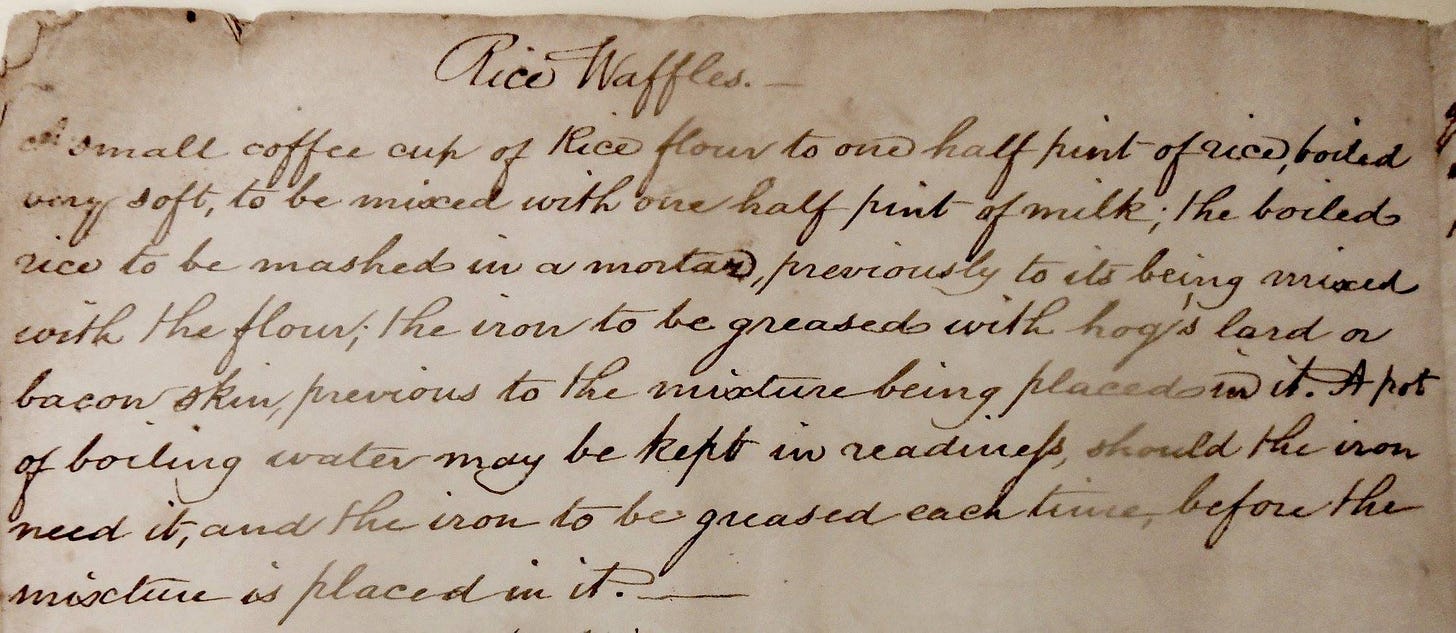Waffles before Waffle House
In 1911 GE introduced the electric waffle iron, a countertop dimpled metal device equipped with a plug in heating element. The design, a bed plate upon which one poured batter, that would be covered by a second heated plate hinged like a book and pulled over by a convenient handle, drew mimicked the stove-top waffle iron patented by Cornelius Swarthout in 1869. In the South the older design of the waffle iron prevailed until the 1930s. Every household of means had a waffle iron in its kitchen—two plates (round or rectangular) of cast iron, sometimes embossed with a design, sometimes simply indented, at the end of long handles with a hinge allowing one to open and close the plates. They were used for hearthside cooking over embers.
One greased the plates liberally with bacon, heated the plates, poured on a batter, closed the plates and extended them over the coals. You flipped the iron once. After a modest period of time you removed the irons from the heat, popped them open and anointed the crispy waffles with butter, cane syrup, sorghum, or your favorite preserves. In the mid-19th century such waffles were a sine qua non of breakfast at a boarding house or hospitable home—served with bacon and corn bread in a kind of trinity. Certain cooks became famous for their waffles—Mrs. Schwarz, who ran a boarding house in Aiken, prepared waffles and bread so sumptuous they became the stuff of wonder in Charleston newspapers in 1830.
The formula for waffle batter varied depending upon one’s locale. In the Lowcountry until 1880 or so the waffle had to have rice, either boiled or in the form of rice flour as a component. The most refined had a crème de riz base, into which one added milk, rice flour, some water and salt. Others combined boiled rice and rice flour with milk and eggs. Sarah Rutledge in the Carolina Housewife offered a recipe that used day old hominy grits as a base into which one added some wheat and a larger measure of rice flour, making a paste which one poured onto the iron. I’ve reproduced the manuscript of a boiled rice & rice flour waffle batter (you have to add salt and some liquid to this) that makes a wonderful crispy waffle that’s like the caramelized Carolina Gold at the base of a rice cookpot.
In the 1880s the Charleston hotels stopped offering waffles in the bread baskets and on breakfast plates. A generation of public diners went without until Jack Bischoff, an ambitious young restaurateur from a family that ran saloons in the 19th-century city revived them. Bischoff championed a Lowcountry version of German food. He opened two restaurants simultaneously in autumn of 1912—The Hanover at 233 Meeting Street and The German Restaurant at 67 Hasell. The latter was surely the most unusual German Restaurant in the country, offering roasted raccoon and sweet potatoes, deviled crabs, shad roe, and shrimp salad a la creole along with wiener snitzel, liver sausages and real rye bread. It deserves recall in Charleston for being the first place in the city to offer “Hamburger Steak.” But its greatest claim to fame was being the restaurant that renovated the reputation of the waffle. Long a fixture of the Lowcountry breakfast, the waffle in Bischoff’s hands was slathered in butter and maple syrup and brought back to starring status on a restaurant bill of fare. One of his advertising tags was, “Are you a Waffle Eater?” He would thrive until the anti-German hysteria of World War 1 drove him out of business. His eateries failed. But the waffles he repopularized remained a menu staple thereafter, albeit using wheat flour rather than rice. The Rice Waffle would not enjoy a renaissance until Zingermann’s Road House introduced its Carolina Gold Rice Waffle, made from rice flour, to its menu. Here’s a picture of a rice waffle made by Sharon123 on her Food Blog. Classic.
I have discussed chicken and waffles elsewhere, so I won’t comment on that 20th century soul food staple here.
“Waffle Iron history,” https://blog.library.si.edu/blog/2010/08/24/waffle-iron-patented/#.XDDP6Px7nK0






